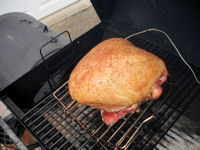
It was about three of four years ago that my
desire to learn more about smoking food really took
off. Many years ago at the food fair I bought what's
best described as a shoebox smoker, very primitive
but it worked and ever since then I've been keen to
discover more about the smoking process and how it
all works. If you fancy trying your hand at smoking
your own food let me explain the processes involved
and how it all fits together.
The origins of smoking were as a way of preserving
food in the days before canning and refrigeration
and there are three steps in the process. The first
of the three steps really is now more about flavor
than preserving and that's salting or curing.
Flavors are now added to curing salts such as herbs
and spices for additional seasoning and the salting
process can take place as a dry cure or a wet cure
(brine). One caveat to what I've written and that
is that there are still areas of the world that rely
on these preservation techniques eg Africa and
poorer parts of Asia. Here preservation is of the
utmost importance.
The second part of the process is weight loss and
this is done in an environment of controlled humidity.
The weight loss is brought about through the
evaporation of moisture from within the tissues and
the logic follows that the greater the weight loss,
the better the keeping qualities. Why dry something
out in a humid environment, surely that's defeating
the object? Well in part yes, but by drying out at a
known humidity therefore takes the guesswork out of
the process and dependent on the food that you are
smoking (and its weight) you will be able to predict
exactly how long the process is going to take.
The third stage is the actual smoking and during
the smoking process tarry deposits from the smoke
settle on the food and these deposits are antiseptic
in nature so they inhibit the growth of bacteria.
The process can be further broken down into hot
smoking and cold smoking.
Cold smoking takes place at between 10 and 29°C and
ensures that the food remains in a raw state at the
end of the smoking process. It's essential that the
tight tolerances of temperature are observed because
if the temperature gets too high then the food will
start to cook and this will change the texture of
the food and it could start to disintegrate. This is
more relevant in countries where the ambient
temperature is quite high where it might not even
be possible to get the temperature below 29°C. Food
smoked and eaten raw is mainly confined to fish but
can include beef.
When hot smoking you are certainly trying to cook
the food whilst imparting the smoked flavor and
because of this the actual temperature is less
important or to put it another way the range is
larger. In the case of fish however there is a
ceiling temperature of 93°C. Hot smoked fish is
usually cold smoked first and then the temperature
brought up to what is really a relatively low
temperature for hot smoking. Mackerel done this
way is absolutely magnificent.
Meat and poultry are smoked at higher temperatures
(110 - 120°C) albeit care must be taken again not to
exceed these temperatures because meat will easily
become dry and frankly unpleasant to eat. Assuming the
temperature is kept within range then meat becomes
difficult to overcook and smoking can continue for
many hours.
Once you have mastered the basics then it really
is easy to smoke your own food. Probably the area
that will require the most experimentation is the
curing because it is quite easy to over-salt food
and to be fair it is also a matter of taste.
|











